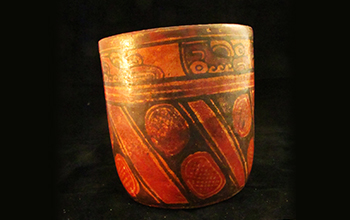Multimedia Gallery
Polychrome pot from ancient Maya village
A polychrome pot unearthed at the ancient Maya village of Ceren in El Salvador. Such pots were prized by the villagers and had likely been obtained through trade at local marketplaces in the valley.
In A.D. 660, the village was blasted by toxic gas, pummeled by lava bombs and then choked by a 17-foot layer of ash falling over several days after the Loma Caldera volcano, less than half a mile away, erupted, leaving Ceren frozen in time.
Learn more about National Science Foundation-supported archaeological research taking place in Ceren in the NSF News From the Field story Buried in ash, ancient Salvadoran village shows images of daily life. (Date image taken: 2000-2015; date originally posted to NSF Multimedia Gallery: Oct. 10, 2019)
Credit: University of Colorado
Images and other media in the National Science Foundation Multimedia Gallery are available for use in print and electronic material by NSF employees, members of the media, university staff, teachers and the general public. All media in the gallery are intended for personal, educational and nonprofit/non-commercial use only.
Images credited to the National Science Foundation, a federal agency, are in the public domain. The images were created by employees of the United States Government as part of their official duties or prepared by contractors as "works for hire" for NSF. You may freely use NSF-credited images and, at your discretion, credit NSF with a "Courtesy: National Science Foundation" notation.
Additional information about general usage can be found in Conditions.
Also Available:
Download the high-resolution JPG version of the image. (2.8 MB)
Use your mouse to right-click (Mac users may need to Ctrl-click) the link above and choose the option that will save the file or target to your computer.



 All images in this series
All images in this series